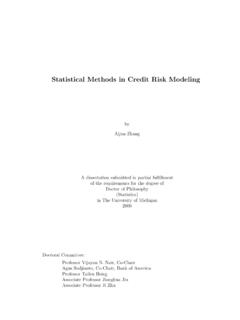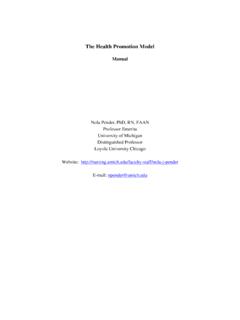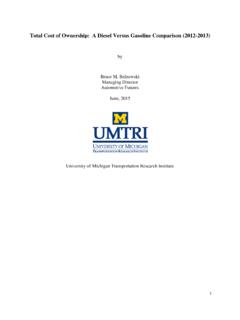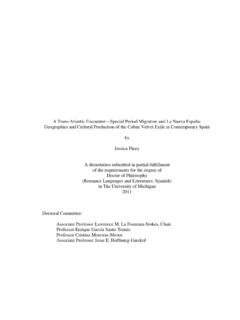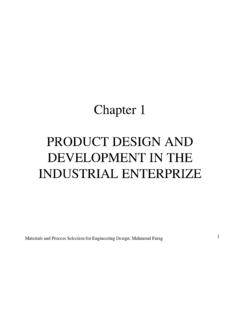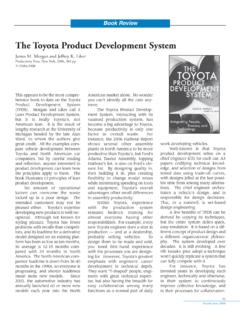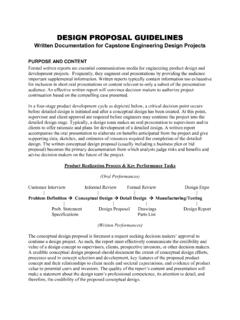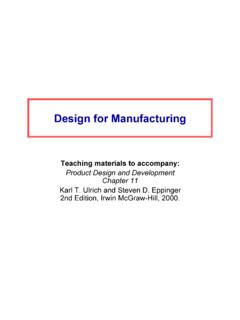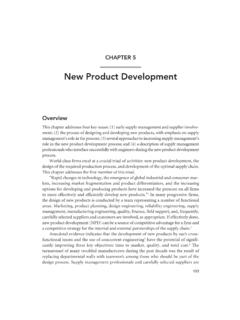Transcription of STRATEGIES FOR NEW PRODUCT DEVELOPMENT
1 C. MERLE CRAWFORD STRATEGIES FOR NEW PRODUCT DEVELOPMENT Guidelines for a critical company problem C. Merle Crawford is a faculty member at the University of Michigan. In spite of much evidence of its success, many managers hesitate to establish a policy for new PRODUCT DEVELOPMENT . Their indecision often arises from two reasons: they fear that a defined strategy may discourage innovation and they are uncertain how to formulate a new PRODUCT strategy. The author of this article discredits the former notion and, in reply to the latter, proposes the guidelines for developing such a statement.
2 As new products are essential to the continued success of most firms, the strategy must exist and must be operant if the firm is to avoid wasted time, effort, and money as well as employee con- fusion and discouragement. For longer than most of us care to remember, Dan Gerber has been proclaiming that babies are his business, his only business. With some nostalgic regret I read recently that he has altered his strategy: he now permits limited diversification beyond products for babies. A leading toiletries manufacturer has an equally tenacious, though unpublicized, commitment to only those new, nonfood, packaged goods that do not compete item- to-item with Procter and Gamble.
3 Richard Rifenburgh, president of Mohawk Data Sciences, manufacturers of peripheral computer equipment, was cited recently in Fortune as a man who, at the present time, would rather be an agile follower than a creative leader. 1 On the assumption that it would be too expensive to develop frontiers, Rifenburgh prefers to wait to see on which newly opened trails the volume of activity will fall. All of these companies have a powerful managerial tool-what I call a New PRODUCT DEVELOPMENT Strategy Statement. They have formed convictions concerning new products that seem most appropriate for their respec- tive firms.
4 Under vigorous leadership, their policies are being implemented. Contrast the clarity of these approaches with the following charge given to a PRODUCT DEVELOPMENT group : .. to take the lead in meeting the needs of the company's customers for improved and new products, to develop new uses for existing products, and to develop high-profit products for introduction to existing and potential customers. Research directors who labor under guidance like this are the ones who lament the lack of vision of marketing and top manage- ment personnel: the top brass can't recognize a good PRODUCT idea when it is shown to them.
5 Research operations which "benefit" from the most liberal guidelines also endure 1. Dan Cordtz, "Bringing the Laboratory Down to Earth," Fortune (January 1971 ), p. 106. 49 DECEMBER, 1972 C. MERLE CRAWFORD 50 the most idea rejection, DEVELOPMENT diffi- culties, and PRODUCT failure. Specifically, does the statement of that company limit the search to improving or extending the present PRODUCT line? What degree of relationship to the present scope of activity is necessary for the idea to be acceptable? May the search proceed into unrelated areas?
6 Is search limited to the firm's present technological capabilities, distribution system, raw materials, and plant and human resources? Is the door to acquisition open or dosed? Will functional capability be added to match each new idea, or should the ideas match present functional capabilities? The idea of putting definitive restrictions on the new PRODUCT activity is not novel, but use of it, especially sophisticated use, is still not widespread. Most large firms have some- thing they call new PRODUCT strategy but it is more for directors and stockholders than for serious internal direction; other firms have sketches of such strategy but they are rarely available for personnel down the line from the president's office.
7 As the president of a medium-sized firm recently said to me, not entirely in jest: "Sure, we have a new PRODUCT strategy; just ask me!" Early in this century General Motors committed itself to a full line of automobiles, a strategy that proved superior to Ford's. Only recently did Coca-Cola abandon its strategy of no line additions. General Electric's approach, a broad attack upon markets susceptible to electrical technology, is decades old. Indeed, new PRODUCT STRATEGIES are so old, and in so many cases credited with such successful outcomes, that one is prompted to ask why all firms don't have them.
8 There are essentially two reasons: 1. Management is not certain what such state- ments should cover. 2. Management fears that limitations may discourage some useful or successful inno- vation. These are the points to which we will now turn our attention. WHAT SHOULD THE STATEMENT INCLUDE? The basic purpose of new PRODUCT strategy is to provide unifying direction. It specifically notes any tempting DEVELOPMENT areas that are off limits; it clearly specifies those areas where effort is to proceed; and it adds any other direction appropriate and relevant to the firm, as in the Mohawk strategy.
9 A review of representative strategy state- ments reveals how the following dimensions are in actual use. Technology/Market Mix As long ago as 1957, the Harvard Business Review ran an article by Samuel C. Johnson of S. C. Johnson & Son, Inc. and Conrad Jones of Booz, Allen & Hamilton which became a classic because it spelled out what was rapidly gaining fame as the BA/H method of organizing the new PRODUCT function. 2 The article contained a table which should be on page one of every firm's planning document.
10 It diagramed the alternatives available for new PRODUCT activity as a 3x3 matrix (see accompanying table). This table structurally depicts the possible nine combinations of market and technology. Some, all, or none of these may be encour- aged, as the applicability of each of the options will vary from firm to firm. Unless it values new and improved products for their own sake, any management will want to study thoroughly the various cost/return relation- ships and stipulate those which it wants to stress and those it wishes to avoid.

